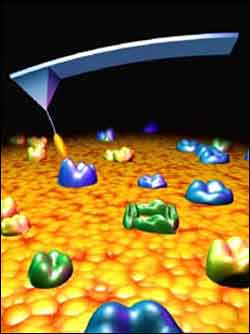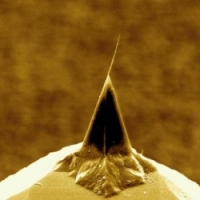 How can we see a world that is too small to see? With our eyes, we can see the world around us because of the light that reflects off the object we are viewing. If we turn off the lights, everything becomes harder to see. To see small atoms and molecules, we need need to use a microscope. The microscope will magnify the light reflecting off the object with a powerful lens so that we can see an enlarged virtual image of that tiny object.
How can we see a world that is too small to see? With our eyes, we can see the world around us because of the light that reflects off the object we are viewing. If we turn off the lights, everything becomes harder to see. To see small atoms and molecules, we need need to use a microscope. The microscope will magnify the light reflecting off the object with a powerful lens so that we can see an enlarged virtual image of that tiny object.
The smallest thing that we can see with a ‘light’ microscope is about 500 nanometers. One nanometer is one-billionth (that’s 1,000,000,000th) of a meter. So the smallest thing that you can see with a light microscope is about 200 times smaller than the width of a human hair. Bacteria are about 1000 nanometers in size. The reason we can’t see anything smaller is because these microscopes use light. Normally, we don’t think about light as having a size, but visible light is about 500-800 nanometers. To see anything smaller we need a more powerful microscope.
 The atomic force microscope is one of the world’s most powerful microscopes. They don’t see things with light. Instead, they use a very sharp tip that looks like a needle to “feel” the surface of the object they are trying to see. Sometimes, scientists will put carbon nanotubes at the end of the sharp tip to make them even sharper. A carbon nanotube tip is so sharp, it is only a few atoms wide.
The atomic force microscope is one of the world’s most powerful microscopes. They don’t see things with light. Instead, they use a very sharp tip that looks like a needle to “feel” the surface of the object they are trying to see. Sometimes, scientists will put carbon nanotubes at the end of the sharp tip to make them even sharper. A carbon nanotube tip is so sharp, it is only a few atoms wide.
This tip is so sharp that as it is moved across something, the tip can feel the shape by measuring the forces between the atoms on the tip and the atoms on the object. Using powerful computers, all this information about the forces can be used to create a three-dimensional view of the object. With an atomic force microscope, you can see things as small as a strand of DNA. This is how scientists have been able to “see” DNA and show that it is truly double helix shaped like Watson and Crick showed over 50 years ago.
Image Source: Innovations Report
